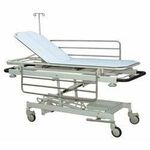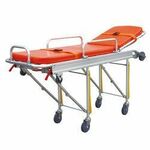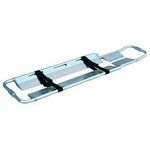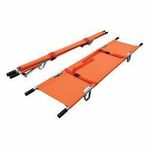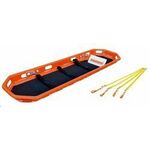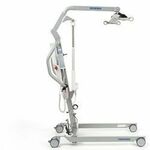Stretcher
What is a Stretcher?
A stretcher is used to transport patients who are injured, sick, or unable to move on their own. It is commonly used in hospitals, ambulances, and emergency situations. Stretchers are designed to provide support and safety while moving patients from one place to another. They can be made of metal or strong plastic and often come with a fabric or padded surface for comfort. Some stretchers are designed to be carried by two people, while others have wheels for easier movement.
There are different types of stretchers for different medical needs. Basic stretchers are lightweight and foldable for easy transport, while advanced models have adjustable features, such as height control, side rails, and safety straps. In hospitals, stretchers with built-in mattresses and IV stands help provide better care during transportation. No matter the type, stretchers play a crucial role in patient safety and emergency medical services.
What are the advantages of Stretcher?
A stretcher is designed to provide comfort, stability, and ease of movement in emergencies and medical settings.
Advantages of a Stretcher:
Stretchers ensure that patients are moved without causing further injury, especially in emergency situations like accidents or surgeries.
Many stretchers have wheels, allowing medical staff to transport patients quickly and smoothly within hospitals or ambulances.
Padded surfaces and adjustable features help keep patients comfortable during transport, reducing pain and stress.
Stretchers are essential for ambulances, rescue operations, and disaster relief, helping move patients efficiently in critical situations.
Some stretchers come with height adjustments, IV stands, safety straps, and foldable designs, making them useful for different medical needs.
What are the features of Stretcher?
A stretcher comes with various features that ensure comfort, stability, and ease of use in hospitals, ambulances, and emergency situations.
Features of a Stretcher:
Strong and Durable Frame: Made of metal or reinforced plastic to support the patient’s weight while being lightweight for easy handling.
Comfortable Surface: Some stretchers have padded or cushioned surfaces to provide comfort, while others use strong fabric for flexibility.
Wheels for Easy Movement: Many hospital and ambulance stretchers have wheels with brakes, allowing smooth transportation and stability.
Foldable and Portable Design: Some stretchers can be folded for easy storage and transport, especially in rescue and emergency situations.
Height Adjustment: Advanced stretchers allow height adjustments to help medical staff provide care without bending or straining.
Safety Straps and Side Rails: To keep patients secure during transport, many stretchers come with straps and foldable side rails.
Overview of Stretcher Price Range:
Stretchers come in various types and designs, each suited for different medical and emergency needs. The price range of stretchers typically starts from INR 2,000 for basic models and can go up to INR 1,00,000 for advanced, feature-rich stretchers used in hospitals and ambulances.
Here is the Price list of Stretcher:
| S.N. | Stretcher | Price |
| 1. | 11 Enterprises Patient Stretcher Trolley Powder-Coated | INR 9,856 |
| 2. | ACME Stretcher Trolley Special Design, 2004A | INR 16,241 |
| 3. | ACME 2003 Patient Trolley (S.S.) | INR 28,493 |
| 4. | ACME 2002 Stretcher Trolley | INR 38,323 |
| 5. | Niscomed Autoloader Collapsible Stretcher | INR 45,588 |
| 6. | NISCOMED STRETCHER CUM WHEELCHAIR | INR 94,026 |
*Price maybe subject to change.
Different Types of Stretcher:
Different types of stretchers are designed for specific medical needs, ensuring patient comfort, stability, and ease of movement. Below are the different types of stretchers and their uses.
1. Stretcher Trolley:
A stretcher trolley is a hospital stretcher with wheels, allowing easy patient transport within medical facilities. It often has adjustable height, breaks for stability, and a comfortable padded surface. Some advanced models include IV pole holders and safety rails for better patient care.
2. Ambulance Stretcher:
An ambulance stretcher is designed for emergency medical transport. It usually has collapsible legs, safety straps, and a sturdy frame for smooth movement. Some models have shock-absorbing features to minimize discomfort during transport in an ambulance.
3. Scoop Stretcher:
A scoop stretcher is a specialized stretcher that splits into two halves, allowing medical personnel to slide it under a patient without lifting them. It is mainly used for patients with spinal injuries, as it helps reduce movement and prevents further damage.
4. Folding Stretcher:
A folding stretcher is a lightweight, portable stretcher that can be folded for easy storage and transport. It is commonly used in rescue operations, military settings, and disaster relief due to its easy handling and space-saving design.
5. Spine Board:
A spine board is a rigid stretcher used to immobilize patients with suspected spinal cord injuries. Made of strong, lightweight materials like plastic or fiberglass, it ensures that the patient remains stable during transport to prevent further injury.
6. Basket Stretcher:
A basket stretcher is designed for rescue operations in difficult terrains, such as mountains, water, or disaster zones. It has a protective frame to secure the patient and is often used with ropes or helicopters for airlifting.
7. Patient Lifter:
A patient lifter is used to lift and transfer patients who have mobility issues. It is commonly used in hospitals and home care settings to help patients move from a bed to a wheelchair or stretcher without strain.
Stretcher Price list according to types:
| S.N. | Stretcher Types | Min Price | Max Price |
| 1. | Stretcher Trolley | INR 10,000 | INR 100,000 |
| 2. | Ambulance Stretcher | INR 15,000 | INR 80,000 |
| 3. | Scoop stretcher | INR 7,000 | INR 50,000 |
| 4. | Folding Stretcher | INR 2,000 | INR 25,000 |
| 5. | Spine Board | INR 5,000 | INR 30,000 |
| 6. | Basket Stretcher | INR 10,000 | INR 60,000 |
| 7. | Patient Lifter | INR 20,000 | INR 100,000 |
Top Manufacturers of Stretcher:
Several manufacturers produce high-quality stretchers to meet the needs of hospitals, ambulances, and emergency services. These brands offer a wide range of stretchers with different features to ensure patient safety and comfort. Below are some of the top manufacturers known for their durable and innovative designs.
1. Aadrash:
Aadrash is a well-known manufacturer of medical equipment, including stretchers. Their products are designed with strong materials and user-friendly features, making them ideal for hospitals and emergency services. Aadrash offers a variety of stretchers, including trolley stretchers, ambulance stretchers, and foldable stretchers.
2. Aar Kay:
Aar Kay specializes in producing high-quality medical stretchers with advanced features such as height adjustment, hydraulic mechanisms, and durable frames. Their stretchers are widely used in hospitals and ambulances, ensuring smooth and safe patient transport. They are known for their ergonomic designs and reliability.
3. ACME:
ACME is a reputed brand in the medical industry, offering a wide range of stretchers for different medical and rescue applications. Their stretchers include spine boards, scoop stretchers, and folding stretchers, designed for quick and easy patient handling in emergencies. ACME is known for its strong and lightweight designs.
4. Avishkar:
Avishkar manufactures premium stretchers with a focus on comfort and durability. Their ambulance stretchers, basket stretchers, and patient lifters are widely used in healthcare facilities. They ensure high safety standards with strong frames, secure straps, and smooth mobility features for patient transport.
5. Elite Plus:
Elite Plus is a trusted brand offering a variety of stretchers, including transport trolleys, scoop stretchers, and rescue stretchers. Their products are designed for both medical and emergency use, providing stability and ease of operation. The brand is known for its innovative designs and affordability.
Below is the price range of different stretcher brands:
| S.N. | Stretcher Brands | Min Price | Max Price |
| 1. | Aadrash | INR 5,000 | INR 80,000 |
| 2. | Aar Kay | INR 7,000 | INR 90,000 |
| 3. | ACME | INR 3,500 | INR 75,000 |
| 4. | Avishkar | INR 6,000 | INR 85,000 |
| 5. | Elite Plus | INR 2,000 | INR 1,00,000 |
Things to be considered before buying a Stretcher:
Choosing the right stretcher is essential for ensuring patient safety, comfort, and ease of transport. The selection depends on various factors such as usage type, material quality, and additional features. Here are the key things to consider before buying a stretcher:
Type of Stretcher: Determine whether you need a stretcher. Different types, such as trolley stretchers, scoop stretchers, and folding stretchers, serve different purposes.
Weight Capacity: Check the maximum weight limit of the stretcher to ensure it can safely accommodate the patient. Standard stretchers usually support 120-250 kg, while bariatric models can handle more weight.
Material and Durability: Stretchers should be made from high-quality aluminum, stainless steel, or reinforced plastic to ensure durability, stability, and resistance to rust or wear.
Mobility and Wheels: If you need a stretcher for transport, choose one with smooth-rolling wheels, brakes, and shock absorption to ensure safe and stable movement.
Adjustability and Folding Mechanism: Some stretchers come with height adjustment, reclining backrests, or foldable designs for easy storage and transport, making them more versatile.
Safety Features: Look for essential safety features such as side rails, safety belts, and locking mechanisms to keep the patient secure during movement.
Ease of Cleaning and Maintenance: Medical equipment should be easy to clean and disinfect to maintain hygiene and prevent infections. Stretchers with waterproof and stain-resistant materials are ideal.
Budget and Brand: Consider the price range and brand reputation before making a purchase. Reliable brands like Aadrash, Aar Kay, ACME, Avishkar, and Elite Plus offer quality stretchers at different price points.
Why Should You Buy a Stretcher from Biomed Supplier?
Biomed Supplier is a trusted source for high-quality medical equipment, including stretchers. We offer a wide range of durable, reliable, and cost-effective stretchers suitable for hospitals, ambulances, and emergency services. Here are the key reasons to choose Biomed Supplier:
Wide Variety of Stretchers: We provide different types of stretchers, including trolley stretchers, ambulance stretchers, scoop stretchers, and folding stretchers, catering to various medical needs.
High-Quality Products: Our stretchers are made from premium materials like stainless steel and aluminum, ensuring durability, stability, and long-lasting use.
Competitive Pricing: Biomed Supplier offers affordable pricing with options for both budget-friendly and premium stretchers, making them accessible for different healthcare facilities.
Certified and Trusted Brand: We deal with top brands such as Aadrash, Aar Kay, ACME, Avishkar, and Elite Plus, ensuring quality and reliability.
Customizable Options: Some stretchers come with adjustable height, reclining backrests, safety belts, and additional accessories, allowing customization based on medical requirements.
Reliable Customer Support: We provide excellent after-sales service, warranties, and customer support, ensuring a hassle-free buying experience.
FAQ's:
1. What is a stretcher used for?
A stretcher is used to transport patients safely in hospitals, ambulances, and emergency situations. It helps in moving injured or immobile patients with ease.
2. What are the different types of stretchers?
There are various types of stretchers, including stretcher trolleys, ambulance stretchers, scoop stretchers, folding stretchers, spine boards, basket stretchers, and patient lifters. Each type serves a specific purpose.
3. What is the price range of a stretcher?
Stretchers can cost between INR 2,000 to INR 1,00,000, depending on the type, brand, features, and material used.
4. What should you consider before buying a stretcher?
Factors to consider include type of stretcher, weight capacity, material quality, mobility, adjustability, safety features, and budget.
5. Which brands manufacture high-quality stretchers?
Top brands include Aadrash, Aar Kay, ACME, Avishkar, and Elite Plus. These manufacturers provide reliable and durable stretchers.
6. What is the weight capacity of a stretcher?
Most standard stretchers support 120-250 kg, while bariatric stretchers can hold heavier patients.
7. Are ambulance stretchers different from hospital stretchers?
Yes, ambulance stretchers are designed for emergency transport and often have folding legs, wheels, and locking mechanisms, whereas hospital stretchers may have adjustable backrests and side rails for patient comfort.
8. How do you clean and maintain a stretcher?
Use disinfectants and mild cleaners to wipe the surface regularly. Check for damaged wheels, locks, or belts and replace worn-out parts as needed.

